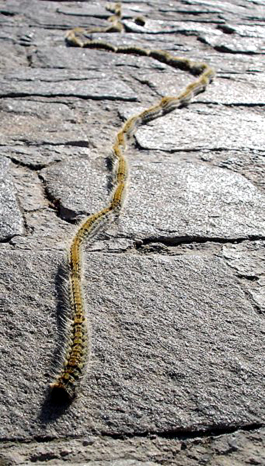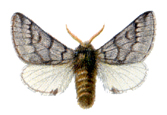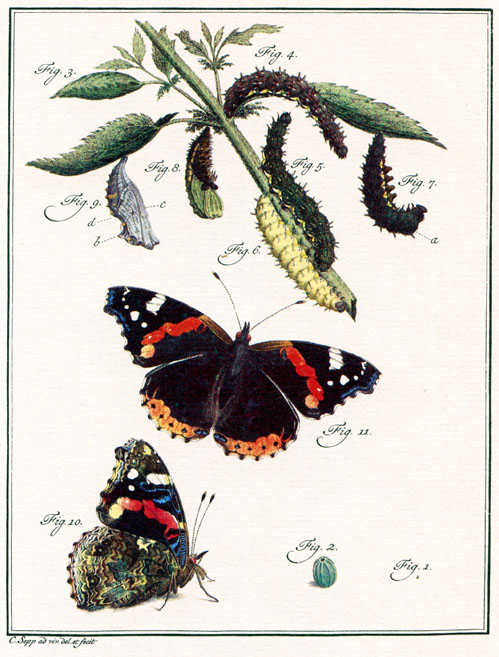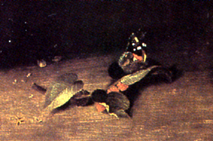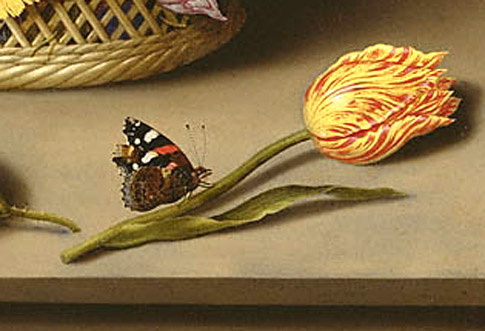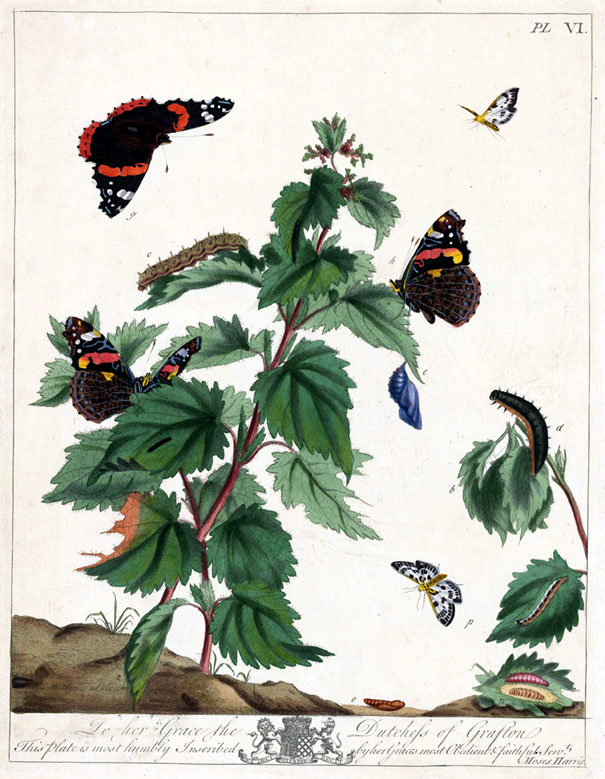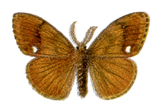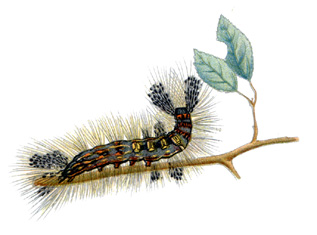Butterflies and Moths in Nabokov's Published Writings
Alphabetical Order ‒ Page 11
... Q-S ... * T-Z *
Talicada nyseus Guérin-Ménéville, 1843 [Lycaenidae, Polyommatinae, Polyommatini, Everes Section]: the Red Pierrot, in Sri Lanka, S India, N Myanmar. This is an unusual lycaenid, with a wingspan of c. 30 mm and no blue or copper at all. It is basically cream-colored, with a broken broad blackish border along the forewings and a cinnamon one along the lower hindwings.
*Lep9 45
Tegeticula (ex Pronuba) yuccasella Riley, 1872 [Prodoxidae]: This is a small moth with a wingspan of 18–28 mm found in and around the flowers of yucca plants. The forewings are white, the hindwings brownish gray. The range is from Mexico and Texas through the Great Plains to southernmost Canada and east to S Ontario and Connecticut. Their habitat is sand dunes, pine forests and grassland. Humbert Humbert, being no entomologist, errs when he observes: "… yucca blossoms, so pure, so waxy, but lousy with creeping white flies." As Nabokov explained in a letter to Alfred Appel, Jr.: "The insects that poor Humbert mistakes for 'creeping white flies' are the biologically fascinating little moths of the genus Pronuba whose amiable and indispensable females transport the pollen that fertilizes the yucca flowers."
The True Yucca Moth is a schoolbook case of coevolution, or mutualism. Neither the yucca plant nor the moth could exist without each other. The yucca plant sprouts a stalk of white flowers at the end of May. Bees are not attracted to them, and the pollen is too sticky for the wind to blow it around. On the other hand, the caterpillar of the moth feeds only on yucca seed. The moth (caterpillar and imago) lives inside the flower and mates there. Pollination takes place between dusk and midnight, when the females visit neighboring yucca plants, carrying a ball of pollen "under their chins".
*Lol 156; SelLet 414–415
& Ac: Tegetícula/Pronúba yuccasélla • Am: True Yucca Moth
Tephroclystis Hübner, 1825 (or Tephroclystia Hübner, 1816): an abandoned generic name of geometer moths (»Geometridae), subfamily Larentiinae. Its species have been transferred to the genera »Eupithecia curtis, 1825, Hydrelia Hübner, 1825 and Prorella Barnes & McDunnough, 1918.
*NabBut 212 (FB)
Terzit: »Polyommatus thersites
Thais polyxena: »Zerynthia polyxena
Thais rumina f. medisicaste: »Zerynthia rumina
|
Thaumetopoea pityocampa - Larvae (Wikipedia) and moth (Lampert 1907) |
|
|
|
|
Thaumetopoea Hübner, 1816 [Notodontidae]: a Palearctic genus of prominent moths, by some authors considered a family of its own (Thaumetopoeidae). The hairy caterpillars make large webs on the branches of trees and go out in columns to feed, single file, front touching rear. Sometimes they happen to go in a circle, and they may keep on moving this way for a week, eventually dying of starvation. The hairs are poisonous, causing a strong itch and skin inflammations. The type-species is Thaumetopoea processionea Linnaeus, 1758, in oak forests of C and S Europe. Thaumetopoea pityocampa DENIS & SCHIFFERMÜLLER, 1775, the Pine Procession Moth, is the worst pine forest pest in the Mediterranean region and the Near East.
The "six-inch-long caterpillar, with fox-furred segments" unwarned Van picks up in Ada probably is not one but five or six Procession Moths glued together. They leave "itchy bright hairs" in his fingertips that he tries for hours to get rid off.
*SebKn 186; Ada 449
& Ac: Thaumetopóea processionéa • En: Oak Procession Moth • Fr: la processionnaire du chêne • Ge: Eichenprozessionsspinner • Ru: дубовый походный шелкопряд • Sp: procesionaria del roble/de la encina
& Ac: Thaumetopóea pityocámpa • En: Pine Procession Moth • Fr: la processionnaire du pin • Ge: Pinienprozessionsspinner • It: Processionaria del Pino • Sp: procesionaria de los pinos
Thecla Fabricius, 1807: a genus of »Lycaenidae, subfamily Theclinae (hairstreaks), with »Thecla betulae as type-species. The Theclinae are distinguished by a very short tail on each hindwing.
*NabBut 268 (L), 610 (BE); LtVé 467
Thecla acaciae var. abdominalis: »Satyrium abdominalis
Thecla betulae, f (Verity 1943)
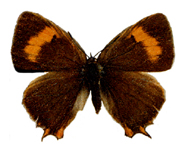
Thecla betulae Linnaeus, 1758 [Lycaenidae]: a Palearctic hairstreak in deciduous woodlands from Europe across temperate Asia to Korea, except for the southernmost and northernmost zones, up to altitudes of 1,000 m. The wingspan is 32–37 mm. Males and females are chocolate brown dorsally and light brown ventrally. The females have prominent orange markings on their forewings.
Thecla betulae is the type-species of the genus Thecla Fabricius, 1807 and as such something like the prototype of all the theclines (»Lycaenidae).
& Ac: Thécla bétulae • En: Brown Hairstreak • Fr: le thécla du bouleau • Ge: Nierenfleck, Birkenfalter • Ru: хвостатка березовая • Sp: topacio
Thecla bieti: »Esakiozephyrus bieti
Thecla ilicis: »Satyrium ilicis
Thecla spini: »Satyrium spini
Thecla verae Nab.: "Véra's Thecla," an imaginary butterfly Nabokov drew for his wife on Christmas, 1971.
*Véra's Butterflies, p. 22
Thecla w-album: »Satyrium w-album
Theclinae SWAINSON, 1831: hairstreaks, a subfamily of »Lycaenidae. In a letter to Cyril dos Passos, Nabokov speaks of "a specimen of one of the rarest 'psittacoid' S. American Theclinae". Robert M. Pyle suggests that "Psittacines are woodpeckers; 'psittacoid' may refer to a unique beak-like process on the genitalia of the hairstreaks he speaks of" (Nabokov's Butterflies, p. 730). Actully psittacines are parrots, and "psittacoid" could also refer to the parrot-like colors of that rare S American hairstreak.
*NabBut 385 (L)
thecline: any member of the subfamily Theclinae (»Lycaenidae).
Thersamolycaena (ex Chrysophanus, Heodes, Lycaena) alciphron Rottemburg, 1775 [Lycaenidae, Lycaeninae]: the Purple-shot Copper, in Morocco, W and C Europe, Turkey, Iran, S Urals, S Siberia, Altai, Mongolia.
*Lep2 270
Thersamolycaena alciphron gordius Sulzer, 1776 [Lycaenidae, Thersamolycaena]: a subspecies of the Purple-shot Copper described from the Engadina, canton Grisons, Switzerland. "The type locality has been limited by Verity (1943) to Chiavenna, N. of Lake Como. Common in the hills and mountains of S. Switzerland (up to 2000m. in the Simplon), S. Tirol, Italy & S. France. A number of local forms of this subspecies have been described, some transitional in regard to the nominal race. I can see no subspecific difference between the individuals I took at Menton and Moulinet (A.M.) and those I took on the Simplon road and elsewhere in S. Switzerland."
*NabBut 604–5 (BE)
Thersamolycaena dispar, m+f (Hofmann 1894)
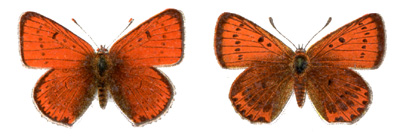
Thersamolycaena (ex Lycaena) dispar Haworth, 1803 [Lycaenidae, Lycaeninae]: a Palearctic copper with a wingspan of c. 30 mm of which only isolated colonies survive in C and SE Europe and across Asia to the Amur region. It was first described in 1803 from England, but the last specimens there were sighted in the 1850s. Due to the draining of swamps which along with wet meadows are its natural habitat, the resident subspecies (Thersamolycaena dispar dispar) has become extinct on the British isles. Since then, two other varieties (mainly the larger Dutch batava Oberthür, 1921, occurring only in the peat bogs of De Wieden and in S Friesland, Netherlands) have been introduced to Britain from the Continent since 1927, with limited success. The name is due to the fact that males and females are quite dissimilar. In the males, both wings are a brilliant orange with a narrow dark brown border; in the females, there are dark brown dots, broader brown margins and dull hindwings with a copper band.
"The butterfly was first taken in a Huntingdonshire fen in the early 1790s … One of the last specimens was taken at Holme Fen, Cambridgeshire in 1847 or 1848 and a very last one was caught in the Somersetshire marshes in 1857… The artificial establishment of a Dutch race at Wicken in 1929–30 since when it has unfortunately thrived is to be deplored" ("Butterflies of Europe", 1964). There is a note to this in Nabokov's Butterflies (p. 738): "Actually, the reintroduction of Dutch Large Coppers to Britain has taken hold at Woodwalton Fen National Nature Reserve, not Wicken Fen. Not really thriving, they are maintained through aggressive care and habitat management, and are said to resemble the extinct British race now more than the Dutch founder race, by some measures."
From the official UK Biodiversity website: "The large copper butterfly became extinct in the UK in 1851. It was last recorded at Bottisham Fen in Cambridgeshire and, although the species was never widespread, there is good evidence that its former range also included Lincolnshire, Huntingdonshire, Norfolk and Somerset. A rare Dutch subspecies, L. dispar batavus, was introduced to Woodwalton Fen in Cambridgeshire in 1927. The population has subsequently had to be re-introduced or supplemented on several occasions, from captive stock. The butterfly is listed as a globally threatened species by IUCN/WCMC."
From the Cambridgeshire County Council website: "The Woodwalton Fen population has never been self-sustaining as an isolated population. The reason for this may be the unusually large overwinter mortality observed (over 90% mortality). The last release was carried out in 1987, and this species became extinct in the wild again in 1992. The remaining population in a glasshouse on the site have now been moved from the reserve and split between a university and a butterfly house. There are no plans to reintroduce the large copper butterfly in the foreseeable future."
*SebKn 41; NabBut 478 (L), 605 (BE), 738
& Ac: Thersamolycáena/Lycáena díspar • En: Large Copper • Fr: le cuivré des marais • Ge: Großer Feuerfalter • Ru: червонец непарныи • Sp: manto grande
Thersamolycaena dispar (from John Curtis: British Entomology, 1840)
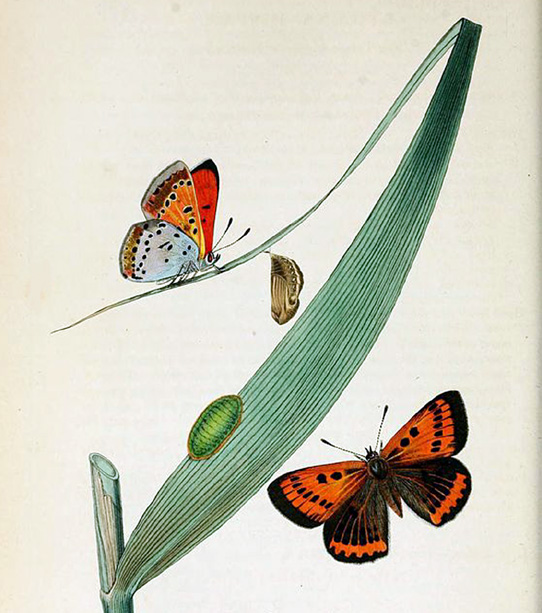
Thersamolycaena (ex Lycaena) dispar var. batava Oberthür, 1921 [Lycaenidae, Lycaeninae]: a very local variety of the Large Copper in some fens of Friesland in Holland.
Thersamonia (ex Lycaena, Chrysophanus) thersamon Esper, 1784 [Lycaenidae, Lycaeninae]: the Lesser Fiery Copper, in Italy, S and SE Europe, Turkey, Levant, Iraq, Iran, Afghanistan, Ukraine, S Urals, Altai.
*Lep1 30
thistle butterfly: the regular Russian, German and a rare English common name of »Vanessa cardui, the Painted Lady.
*Gift 111
Thor's Fritillary: »Clossiana thore
Thorybes pylades Scudder, 1870 [Hesperiidae, Pyrginae]: the Northern Cloudy Wing, from Quebec to British Columbia and southward to Florida, Texas, Baja California and SC Mexico.
*NabBut 398 (L)
Thymelicus (ex Adopoea) acteon Rottemburg, 1775 [Hesperiidae, Hesperiinae]: the Lullworth Skipper, in N Africa (including Canary Islands), S and C Europe, Asia Minor, Lebanon.
*NabBut 611 (BE)
Thymelicus (ex Adopoea) flava PONTOPPIDAN, 1763 [Hesperiidae, Hesperiinae]: an invalid synonym of »Thymelicus sylvestris PODA, 1763.
Thymelicus (ex Adopoea) lineola Ochsenheimer, 1808 [Hesperiidae, Hesperiinae]: a skipper similar to the Small Skipper (»Thymelicus sylvestris), but mostly somewhat smaller, in N Africa, Europe, C Asia, Tianshan, Amur basin. It has also been introduced to N America.
*Lep2 270
& Ac: Thymélicus linéola • En: Essex Skipper • Fr: l'hespérie du dactyle • Ge: Gestrichelter Braundickkopffalter • Ru: толстоголовка-штрих
Thymelicus (ex Adopaea) sylvestris Poda, 1763, syn flavus Brünnich, 1763, thaumas Hufnagel, 1766, etc. [Hesperiidae, Hesperiinae]: a brown skipper with a wingspan of c. 28 mm, in NW Africa, Europe, Turkey, Middle East, Iran, Caucasus, S Urals.
*Lep1 29; Lep2 270
& Ac: Thymélicus sylvéstris • En: Small Skipper • Fr: la bande noire • Ge: Braunkolbiger Braundickkopffalter • Ru: толстоголовка овсяницевая
Thymelicus thaumas: »Thymelicus sylvestris
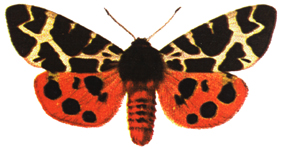
tiger moth: any member of the family »Arctiidae.
In The Gift (p. 110), there is mention of "the small resonant tympanum of certain tiger moths". There are some tiger moths that emit a small stridulent sound when flying, especially those of the genera Setina Schrank, 1802 (ex Endrosa Hübner, 1819) and Arctia Schrank, 1802. The C American Melese laodamia Druce, 1884 is known to emit audible and ultrasonic sounds. When disturbed, the Holarctic Arctia caja Linnaeus, 1758 emits a small sound that is audible to the human ear. It is a night-flying moth with a wingspan of 65–80 mm. The forewings have a brown and white warning pattern, the hindwings are orange with dark blue eyespots meant to make the predator hesitate, giving the moth a chance to escape.
While the stridulations of male cicadas and several other insects are produced by the tympanic organs at the end of their thorax where a muscle contracts to make a tympanum vibrate, the tympanal organs which are found at the end of the thorax of many arctiid, noctuid, notodontid and lymantriid night-flying moths are not used for sound production. Their function was unknown at the time The Gift was written. They serve to detect the ultrasonic shrieks of approaching bats before they can locate the moth. The moth will drop down immediately, thus making itself "inaudible" to the predator. The tympanal organ may also serve to detect the ultrasound produced by conspecifics of the opposite sex at the time of courtship.
Those tiger moths that produce sounds don't do so by their tympanal organs but by a tymbal on the middle segment of their thorax which is made to vibrate by a muscle. Perhaps these sounds also serve to alert birds that this is a distasteful moth (Arctia caja, for instance, really is), for protective devices like "bad taste" are useful to a species only as long as predators know it before trying.
The Tigermoth of Lolita ("I picked her up one depraved May evening somewhere between ... Toylestown and Blake, at a darkishly burning bar under the sign of the Tigermoth, where she was amiably drunk") is a double reference: (1) To the neon sign of some bar displaying what looks like an Arctia species. (2) To William Blake's famous poem "The Tyger" (1794): "Tyger tyger burning bright / In the forests of the night ..."
*Gift 110; Lol 258; SelLet 414
& En: tiger moth • Fr: l'écaille • Ge: Bärenspinner • It: orso • Ru: медведицы, (Nabokov) арктид • Sp: arctia
& Ac: Árctia cája • En: Great Tiger Moth • Fr: l'écaille martre, la hérissonne • Ge: Brauner Bär • It: caia, arctia orso bruno • Ru: медведица пылающая • Sp: arctia gitana
Tinea pellionella LINNAEUS, 1758 [Tineidae]: the Case-bearing Clothes Moth.
* LtVé 117
Titania: »Clossiana titania
Tomares Hübner, 1840: a genus of »Lycaenidae, subfamily Theclinae (hairstreaks). The type-species is Tomares ballus Fabricius, 1787, the Provence Hairstreak, in all of N Africa, Iberian Peninsula, S France.
*Lep8 118, 125
Tomares nogelii Caradja, 1895 [Lycaenidae]: a small (27 mm) pale brown-and-orange hairstreak with brown dots, in Romania, Turkey, Ukraine, Crimea, Syria, Lebanon, N Iran.
*StrOps 331
& Ac: Tomáres nogélii • En: Nogel's Hairstreak • Fr: le faux-cuivré de Nogel • Ge: *Nogels Zipfelfalter
Toothwort White: »Pieris virginiensis
tortoiseshell: This common name does not designate any clear-cut taxon. Tortoiseshell butterflies are various members of the genera »Nymphalis Kluk, 1802, »Aglais Dalman, 1816 and »Vanessa Fabricius, 1807 [Nymphalidae, Nymphalinae, Nymphalini] with bright coloring. Their name derives from the tortoiseshell-like appearance of their wings' mottled undersides. The best known European representative is the Large Tortoisehell (»Nymphalis polychloros). The best known American one is »Aglais milberti Godart, 1819, Milbert's Tortoise Shell. The term probably cannot be rendered in any other language; an approximation would be something like the French vanesses and the Italian vanesse which however might need some qualification.
This is exactly how it was rendered in the French translation of The Gift (p. 142): "mes vanesses – petites tortues". As there is explicit mention of Corsican and Arctic forms, we may surmise that the butterfly in question here is »Aglais urticae, the Small Tortoiseshell.
For the tortoiseshell in Ada and Bosch, see under »Aglais urticae.
*Perhaps InvBeh 119; Gift 109; SpeakM 128; Ada 436; Lep1 31; Lep2 255
Tortrix pronubana: »Cacoecimorpha pronubana
Trichoclea sociabilis: »Discestra sociabilis
Triphysa phryne Pallas, 1771 [Nymphalidae, Satyrinae, Coenonymphini]: In "Father's Butterflies," there is a Triphysa zemphyra Godun. mentioned along with "phryne Pall". While zemphyra is an invented species, phryne is not. It is the type-species of a genus of Coenonymphini (US ringlets, GB heaths), Triphysa Zeller, 1850, flying in steppe habitats of E Europe, Siberia and Altai.
*NabBut 204 (FB)
Troides alexandrae, m (from www.nagypal.net)
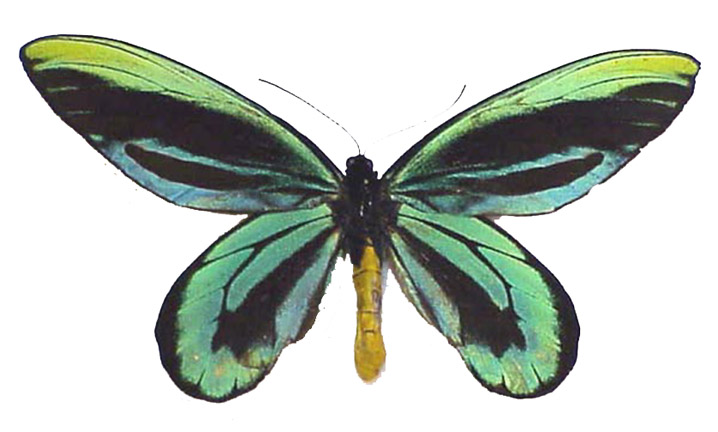
Troides Hübner, 1819, invalid syn Ornithoptera Boisduval, 1832: a genus of very large and mostly brilliantly colored »Papilionidae with elongated forewings. Colloquially they are known as birdwing butterflies. Their range is the Indo-Australian region where they fly high between the treetops, and hunters used to shoot them down. The type-species is Troides helena Linnaeus, 1758, the Common Birdwing of SE Asia. The largest one – and hence the largest of all butterflies – is Troides alexandrae Rothschild, 1907, Queen Alexandra's Birdwing, whose females have wingspans of up to 280 mm. It is restricted to some localities in SE Papua New Guinea. For comparison, the largest moths are »Attacus atlas [Saturniidae] of SE Asia and Australia, with a wingspan up to 240 mm, and Thysania agrippina Cramer, 1776 [Noctuidae, Ophiderinae], the White Witch Moth of tropical C and S America, with a wingspan of up to 280 mm.
*TranspTh 41; LtVé 249
& En: Birdwings • Fr: ornithoptères • Ge: Vogelflügler • Ru: Орнитоптеры
Truncaefalcia Verity, 1953 (not Truncaefolia): an abandoned genus of »Nymphalidae, subfamily Satyrinae, tribe Erebiini (US alpines, GB ringlets and arguses). The type-species was »Erebia aethiops, the Scotch Argus.
*NabBut 591 (BE), 593 (BE)
Twinspot Fritillary: »Brenthis hecate
uralensis: In The Aurelian, the rich collector Sommer browses through the insect dealer's glass boxes containing "tiny vitreous creatures with bright orange feet and belted bodies," very "unlike butterflies". He acts disinterested, but the recognition of a particularly rare specimen gives him away. What is it?
Synanthedon uralensis (Seitz 1912)

There are more than three dozens of species and subspecies named uralensis, that is, occurring in the Urals. Karges (1985) believes the insect in question to be the Euchloe ausonia uralensis Bartel, 1902 (which is an invalid synonym of »Euchloe ausonia volgensis Krulikovsky, 1897) – a most unlikely identification. This ex-uralensis is a pale yellow pierid of average size and neither tiny nor vitreous, nor has it orange feet and a belted body, and it is not "unlike a butterfly" at all.
The insects in Pilgram's boxes very probably belong to the genus Synanthedon Hübner, 1819 in the family of clearwing moths (»Sesiidae), and that particular one will be Synanthedon uralensis Bartel, 1906, flying in S Russia, the Urals, Kazakhstan and Mongolia. The Sesiidae are small moths with glasslike wings that typically mimic wasps, bees, hornets, mosquitoes, flies etc. One characteristic that tells them apart is the number and color of the "belts" around their slender bodies. Sommer will have recognized it by its one red belt in the middle of the abdomen.
*Stor:Aur 251
& Ac: Eúchloë ausónia (uralénsis) • En: Mountain Dappled White
& Ac: Sesíidae • En: clearwing moths • Fr: sésies • Ge: Sesien, Glasflügler • Ru: стеклянницы
Urania moth: In Speak, Memory, there is "a banal Urania moth mounted on plaster," brought back by Cécile Miauton ("Mademoiselle") to make up for the series of whites she had crushed. Véra Nabokov (personal communication) suggested that it might be a SE European owlet moth, Acontia urania Hufnagel, 1767 [Noctuidae, Acontiinae]. This, however, is a humble little insect with a wingspan of c. 30 mm not decorative enough to offer it for sale, mounted on plaster. Mademoiselle will rather have bought some uraniid moth, perhaps of the genus Urania Fabricius, 1807. They are large and brilliantly colored day-flying moths with tailed hindwings native of S America and the Caribbean. Perhaps she even bought one of the showy favorites, the Madagascan Sunset Moth (»Chrysiridia riphearia).
*SpeakM 128
& Fr: (Autres rivages) l'Uranie • Ge: *Urania-Eule
Uraniidae Westwood, 1848: a small family of large moths (wingspread up to 130 mm), most of them in tropical Asia and America, resembling day-flying butterflies and actually flying by day. Many of them are resplendently patterned and colored.
& Ac: Uraníidae • En: uraniids, swallowtail moths • Fr: uraniidés • Ge: Uraniiden • It: uraniidi • Sp: uránidos
Urbanus proteus Linnaeus, 1758 [Hesperiidae, Pyrginae]: the Long-tailed Skipper, a common American skipper, flying from the United States through the West Indies to Argentina. It is comparatively large (wingspan 38–51 mm), has long tails, is pale brown below, dark brown above and distinguished by an intense iridescent bluish-green sheen on the wings, the thorax and the head.
*NabBut 268 (L), 269 (L)
Urbicolidae: a family of butterflies that the British lepidopterist James William »Tutt proposed to split off the »Hesperiidae, or skippers (A Natural History of the British Butterflies, vol. 1, 1905, p. 90–1). It was constructed around his genus Urbicola Tutt, 1905 and was to comprise two subfamilies, the Thymelicinae and the Urbicolinae. The reason for separating this family from the skippers was behavioral rather than morphological: "When absolutely at rest, the butterflies hold the wings erect over the back, but, when sunning themselves, they have a peculiar habit of elevating the forewings and depressing the hindwings, in contradistinction to the Hesperiids proper, which sun themselves with the wings fully expanded." Tutt's Urbicolidae have not caught on. Today, all species of his new family are still regarded as real skippers, in the subfamily Hesperiinae, and his new genus Urbicola is considered a mere synonym of Hesperia Fabricius 1793, with »Hesperia comma as type-species. For his "Butterflies of Europe", Nabokov noted he would have to check Tutt's family.
*NabBut 611 (BE)
Vacciniina Tutt, 1909: an abandoned genus of Lycaenidae, subfamily Polyommatinae (blues). The type-species was Vacciniina optilete Knoch, 1781. In 1997, the genus was included in the genus »Albulina Tutt, 1909. (For details, see under »Polyommatus Section and »Lycaenidae.)
*Lep9 11, 48
vandeleuri: In a letter to Edmund Wilson (Feb 16, 1946), Nabokov says he has named a new butterfly vandeleuri, "in honour of Vandeleur alias Stapleton the villainous entomologist" of Conan Doyle's The Hound of the Baskervilles. There is no vandeleuri in the entomological literature. Perhaps he was joking. For details, see »Luperina berylae.
*N/WLet #138=110old
Vanessa Fabricius, 1807: a cosmopolitan genus of relatively large and beautiful »Nymphalidae, subfamily Nymphalinae, tribe Nymphalini, among them the Camberwell Beauty (»Nymphalis antiopa), the Painted Lady (»Vanessa cardui) and the Red Admiral (»Vanessa atalanta).
*Gift 24: "last year's Vanessas"
Vanessa antiopa: »Nymphalis antiopa
|
Vanessa atalanta and its egg, caterpillar and pupae (Sepp 1762) |
|
|
Vanessa (ex Pyrameis) atalanta Linnaeus, 1758 [Nymphalidae]: the Red Admiral, a dark brown butterfly with brick-red bars and white marks on the tips of its forewings; the wingspan is 50–60 mm. Its range is N to C America, N Africa, S to C and N Europe, Asia Minor, Iran. The Red Admiral is a solitary migrant. Normally it does not pass the winter in freezing climates. It breeds in warmer regions like N Africa and S Europe and then migrates north, sometimes as far as Iceland, breeds here once or twice, and in fall attempts to return south but rarely succeeds. Of those that stay, few survive the winter. The late summer generation likes to feed on rotting plums, pears and apples. The very frequency with which it is mentioned in Nabokov's writings, and the glowing character of his descriptions, make it arguably Nabokov's favorite lepidopteron.
When Alfred Appel, Jr., asked him why he was so fond of Vanessa atalanta, Nabokov answered, "Its coloring is quite splendid and I liked it very much in my youth. Great numbers of them migrated from Africa to Northern Russia, where it was called 'The Butterfly of Doom' because it first appeared in 1881, the year Tsar Alexander II was assassinated, and the markings on the underside of its two hind wings seem to read '1881'. There is something interesting in the Red Admirable's ability to travel so far" (Strong Opinions, p. 170).
The maiden name of "fat, powdered Mrs. Leigh", the mother of Annabel Leigh, Humbert Humbert's first child love, is Vanessa van Ness.
In Pale Fire, Vanessa atalanta seems to be something like the poet John Shade's heraldic butterfly. In his poem, there are the verses:
Come and be worshiped, come and be caressed,
My dark Vanessa, crimson-barred, my blest
My Admirable butterfly …
(lines 269–271, p. 42–43)
Kinbote's commentary (which is etymologically and entomohistorically correct) goes thus: "It is so like the heart of a scholar in search of a fond name to pile a butterfly genus upon an Orphic divinity on top of the inevitable allusion to Vanhomrigh, Esther! In this connection a couple of lines from one of Swift's poems (which in these backwoods I cannot locate) have stuck in my memory:
When, lo! Vanessa in her bloom
Advanced like Atalanta's star
As to the Vanessa butterfly, it will reappear in lines 993–995 (to which see note). Shade used to say that it's Old English name was The Red Admirable, later degraded to The Red Admiral. It is one of the few butterflies I happen to be familiar with. Zemblans call it harvalda (the heraldic one) possibly because a recognizable figure of it is borne in the escutcheon of the Dukes of Payn. In the autumn of certain years it used to occur rather commonly in the Palace Gardens and visit the Michaelmas daisies in company with a day-flying moth. I have seen
|
Vanessa atalanta, details from Jan Brueghel the Elder, "Flower Bouquet", after 1607 (left) and "Flower Still Life" by Ambrosius Bosschaert the Elder (1614) |
|
|
|
|
The Red Admirable feasting on oozy plums and, once, on a dead rabbit. It is a most frolicsome fly. An almost tame specimen of it was the last natural object John Shade pointed out to me as he walked to his doom" (Note "Line 270: My dark Vanessa", p. 172).
In the Index of Pale Fire (p. 314), there are not just these two references to Vanessa atalanta but five: "Vanessa, the Red Admirable (sumpsimus), evoked, 270; flying over a parapet on a Swiss hillside, 408; figured, 470; caricatured, 949, accompanying S's last steps in the evening sunshine, 993." Brian Boyd (personal communication) points out that "these references are all (like all Kinbote's Index references) to entries in the commentary and only secondarily, almost accidentally, to lines in the poem, on the two occasions here where the commentary happens to relate to the line of the poem, however circuitously, in the case of note 270. By following the Index you find some of VN's most haunting and playful references to butterflies, his most elegant examples of crypsis". These are:
Note "Line 408: A male hand", p. 202: "From far below mounted the clink and tinkle of distant masonry work, and a sudden train passed between gardens, and a heraldic butterfly volant en arrière, sable, a bend gules, traversed the stone parapet."
Note "Line 470: Negro", p. 218, discussing skin color: "In defective or premature publications the figures on some plates remained blank. The juxtaposition of the phrases 'a white' and 'a colored man' always reminded my poet … of those outlines one longed to fill with their lawful colors – the green and purple of an exotic plant, the solid blue of a plumage, the geranium bar of s scalloped wing." As a boy, Nabokov had colored John Kirchner's butterfly engravings in Edward »Newman's Illustrated Natural History of British Butterflies and Moths (London 1871).
Note "Line 949: and all the time", p. 277: "We can at last describe his [Gradus's] tie, an Easter gift from a dressy butcher, his brother-in-law in Onhava: imitation silk, color chocolate brown, barred with red …"
All of these are indirect references to Vanessa atalanta. The other direct reference (the one mentioned in Kinbote's note to line 270) is:
Note "Lines 993–995. A dark Vanessa, etc.", p. 290. It is tied to the end of Shade's poem (lines 993–999, p. 69):
A dark Vanessa with a crimson band
Wheels in the low sun, settles in the sand
And shows its ink-blue wingtips flecked with white.
And through the flowing shade and ebbing light
A man, unheedful of the butterfly –
Some neighbor's gardener, I guess – goes by
Trundling an empty barrow up the lane.
Kinbote's commentary reads: "One minute before his [Shade's] death, … a Red Admirable (see note to line 270) came dizzily whirling around us like a colored flame. Once or twice before we had noticed the same individual, at that same time, on that same spot, where the low sun finding an aperture in the foliage splashed the brown sand with a last radiance while the evening's shade covered the rest of the path. One's eyes could not follow the rapid butterfly in the sunbeams as it flashed and vanished, and flashed again, with an almost frightening imitation of conscious play which now culminated in its settling upon the delighted friend's sleeve. It took off, and we saw it next moment sporting in an ecstasy of frivolous haste around a laurel shrub, every now and then perching on a lacquered leaf and sliding down its grooved middle like a boy down the banisters on his birthday. Then the tide of the shade reached the laurels, and the magnificent, velvet-and-flame creature dissolved in it."
Hence in Pale Fire we have two references to Vanessa atalanta in Shade's poem and five in Kinbote's commentary. Two of Kinbote's notes are actually connected to lines in Shade's poem, and both have a relatively "truthful" ring. That is, Kinbote's explanation of 'atalanta' is right, and whatever happened on that garden path, the description of the playful Red Admirable is most vividly realistic. In Brian Boyd's reading of Pale Fire, the spirit of homely and unhappy Hazel Shade is transformed from a "dingy Toothwort White" (»Pieris virginiensis) into an "exuberant atalanta" after her death (Nabokov's Pale Fire, Princeton, New Jersey 1999, p. 140–145).
There is a 500 page book solely on the etymology of scientific butterfly names (Hürter 1998). The author (p. 207–8) cites several theories on the origin of the name 'Vanessa'. The name had been derived from Greek phaíno (to make visible, to make shine), from the Greek word for 'glamour,' from Latin vanesco (to disappear), from Latin vanus (vain) and from Latin vannus (wing). At the end Hürter settles on the correct etymology. The name 'Vanessa' was coined by Jonathan Swift in 1713 and introduced into lepidoptery by the Danish taxonomist Johann Christian »Fabricius in 1807. In Swift's 907 lines poem Cadenus and Vanessa, it stood for Esther Vanhomrigh (1690–1723). 'Cadenus' was an anagram of 'deacon,' that is Swift himself. The poem comments on the unfortunate relationship between Swift and Esther. "Misshessy", as he also called her, the daughter of a Dublin merchant, was a girl of seventeen and twenty-two years his junior when he met her in London about 1707 and became something like a tutor to her. She fell in love with him more than he with her. As he could not bring himself to reject her love completely, their relationship dragged on undecidedly for many years. At the same time he was still involved with the other Esther of his life, Esther Johnson, the 'Stella' of his journal. When in 1714 he had to withdraw to Ireland for political reasons, Esther Vanhomrigh followed him and took residence near him. In 1723 she could not bear their situation any longer and wrote a letter to Esther Johnson, whereupon Swift promptly jettisoned her. She died shortly after. Cadenus and Vanessa, illegally published three years after her death, was written in 1713 and may be read as an attempt to dissuade her from any rash romantic love. It has the lines (307–308) quoted by Kinbote in Pale Fire:
The goddess [Aphrodite] thus pronounced her doom,
When, lo! Vanessa in her bloom
Advanced like Atalanta's star,
But rarely seen, and seen from far ...
Atalanta is a figure from Greek mythology, actually various figures with much in common: a young huntress raised by a she-bear and exceedingly swift who offered to marry the man who would outrun her and killed those who lost the race. One of her suitors was Hippomenes who had been given three golden apples by Aphrodite. Dropping them in her course, he vanquished and won her. However, as Atalanta and Hippomenes lacked in gratitude to Aphrodite and profaned a Cybele shrine by making love in it, both where turned into lions.
It cannot be proven but may very well be that when Danish entomologist J.C. »Fabricius in 1807 was looking for a new generic name for what until then had been Papilio atalanta Linnaeus, 1757, he took it from Swift's poem where Vanessa, Atalanta and (obliquely) even Stella (star) were joined within two lines. Exactly this seems to be Nabokov's (via Kinbote's) theory. Fabricius sojourned in England frequently and seems to have been fully conversant with English literature.
As a generic name, Vanessa just barely made it. Fabricius died in the course of preparing his Systema Glossatorum for publication, and the publisher who had begun to print it in 1807 (Reinhard, in Brunswick) went bankrupt. Only two copies of the first seven sheets survived. They break off on page 112, right in the middle of Fabricius' new genus Vanessa, but before atalanta which was to be its type-species. We know that atalanta was to be one of its species only because the distinguished Berlin entomologist Karl Illiger to whom Fabricius must have sent either his manuscript or his galley proofs published a list of some of the forthcoming new names in his Magazin für Insektenkunde (volume 6, 1807, page 281). According to this preliminary note, Vanessa was to contain thirty species, among them io, atalanta, urticae and levana. The ones actually described in Fabricius' sheets were io, antiopa, bibla, cacta, protogenia, amestris and lamina.
Right before Vanessa, Fabricius had introduced another new genus, Cynthia , with cardui as its type-species (cf. also »Cynthia Vane). As much of Cynthia was later conflated with Vanessa, the name coming first would have had priority, that is, Cynthia, and the much better known Vanessa would have had to be dropped. Only in 1944 did the International Commission on Zoological Nomenclature rule that an exception should be made and Vanessa could stay. Nabokov remarked on this: "On a strict and in my opinion necessary application of the law of priority the name Cynthia F. (1807) & Westwood (1840; type: Papilio cardui L.) should have taken precedence of Vanessa F. The I.C.Z.N. has decided otherwise (for sentimental reasons)" (Nabokov's Butterflies, p. 596).
Fabricius himself had this to say about his choice of names: "The names of the genera don't really matter. Only they should not be too long, and they should not sound unpleasant to the ear. For the diurnal butterflies I chose different cognomina of Venus and for the moths those of Diana. They seem to be the most fitting. The composite ones from the Greek tend to be harsh, long and unpleasant" (Zeitung für Literatur und Kunst in den Königl. Dänischen Staaten [Kiel], September 11, 1807, p. 83).
Nabokov's favored vernacular name of Vanessa atalanta was not 'Red Admiral' but 'Red Admirable'. He thought the word 'admiral' vulgar and much preferred the eighteenth century form found for instance in Moses Harris' famous butterfly book of 1766 (The Aurelian). Nowadays, however, 'admiral' is the name that is generally used, 'admirable" being remembered only by lepidopterists with an entomohistorical turn of mind.
*Stor:Gods 46–47; KQK 44; SpeakM 257, 305; StrOps 169–170, 285, 332; PaleF 42–43, 69, 172, 202, 218, 277, 290, 314; Ada 524; SelLet 113, 500; NabBut 206 (FB); Lep1 31; Lep2 256, 257
& Ac: Vanéssa/Pyraméis atalánta • En: Red Admiral, (Nabokov) Admirable • Fr: le vulcain • Ge: Admiral • It: vulcano • Ru: нимфа Аталанта, (DarII) адмирал • Sp: numerada
|
The "Red Admirable" plate from Moses Harris' The Aurelian (1766) |
|
|
Vanessa atalurticae Nab.: an imaginary butterfly drawn by Nabokov on October 23, 1963, "for Véra from the captor". It is a hybrid of Vanessa atalanta × Aglais (ex Vanessa) urticae, the Red Admiral and the Nettlefly.
*Véra's Butterflies, p. 268
Vanessa cardui (Lampert 1907)
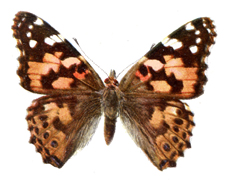
Vanessa (or Cynthia, ex Pyrameis) cardui Linnaeus, 1758 [Nymphalidae]: a strongly migratory species, perhaps with the widest range of all butterflies, arriving in Europe early each summer from the plains of NW Africa, sometimes by the millions in a front many miles wide, and breeding on the way. The generation produced in Europe tries to fly back southward in fall (it may overwinter only in S Spain and on the island of Malta). In N America, they start out on their northward journey from the southwest (where they overwinter) in February. Nabokov pointed out that the Painted Lady's "hibernation" in Europe is nothing but a legend. It is found all over the world except for S America, in forests as well as in city gardens. Its wingspan is 45–60 mm; it has a very distinctive light brown, maroon and white pattern. The larva feeds on thistles and nettles.
"A subtropical species, regularly invading Europe from Africa, and N. America from Mexico. It is found in the whole world except S. America. I have observed in Russia migrants hitting the Crimea in April and breeding in the Yayla plateau. Bleached and tattered their progeny reached Leningrad early in June, producing there one generation in late August. I have observed a tentative southward ebbing in the autumn, but the first frosts soon kill off the night travellers" ("Butterflies of Europe", 1964).
The oldest butterfly painted by man that Nabokov found in an Egyptian mural had features of the Painted Lady (see under »Danaus chrysippus).
*Gift 111; BendSin 156; Ada 436; StrOps 327, 330, 331; NabBut 489, 495 (L), 597 (BE), 603 (BE); Lep1 31; Lep2 257, 270; Lep16
& Ac: Vanéssa cárdui • En: Painted Lady, Thistle Butterfly • Fr: la belle-dame, (Don) la Vanesse des chardons • Ge: Distelfalter • It: vanessa del cardo • Ru: чертополоховка, нимфа чертополоха, (Dar) репейница • Sp: vanessa de los cardos, bella dama, cardero
Vanessa incognita: "the unknown Vanessa," an imaginary butterfly Nabokov drew for his wife on April 23, 1962. Unlike real Vanessas that are mostly brown, black, red and white, its basic color is blue.
*Véra's Butterflies, p. 12
Vanessa io: »Inachis io
Vanessa polychloros: »Nymphalis polychloros
Vanessa urticae: »Aglais urticae
Vanessa verae: "Véra's Vanessa," an imaginary butterfly Nabokov drew for his wife on February 8, 1957. It looks much like »Vanessa atalanta, only the bands are not red but blue.
*Véra's Butterflies, p. 24
Vanessa (ex Cynthia) virginiensis Drury, 1773, syn huntera Fabricius, 1775 [Nymphalidae]: the American Painted Lady (or Hunter's Butterfly), from S Canada to Colombia, and from coast to coast.
*NabBut 398 (L)
|
Orgyia antiqua and its caterpillar (Lampert 1907) |
|
|
|
|
vaporer (caterpillar): Most of the more than sixty members of the cosmopolitan genus Orgyia Ochsenheimer, 1810 [Lymantriidae, tussock moths] go by the name vaporer moths. The main representative and type-species is the Common Vaporer or Rusty Tussock Moth, Orgyia antiqua Linnaeus, 1758, in temperate Europe and Asia. The name tussock moth derives from the tufts of hair on the caterpillar that make it look like a "fancy toothbrush". They are irritant and can cause serious rashes. The name Vaporer, or braggart, is due to the fact that the females in most of the species have only very rudimentary wings and cannot fly and barely move. They have been called a tub full of eggs, waiting to be fertilized. The males on the other hand fly with a rapid quivering zigzag motion as if bragging before them.
The description, in Ada, of the caterpillar of the "Vaporer fellow" ("its black coat enlivened all along the back with painted tufts, red, blue, yellow, of unequal length, like those of a fancy toothbrush treated with certified colors") does not fit Orgyia antiqua which has only yellow tufts. On the next page there develops a "Persian Vaporer" from the larva. A vaporer moth occurring in Iran is Orgyia dubia Tauscher, 1806, ranging from N Africa, Iberian Peninsula, Sicily, Near East, Asia Minor, Iran, Armenia to S Russia and C Asia. Its wingspan is 25 mm, and it has orange, yellow and brown marks, but the tufts on the caterpillar are white and black. The females not only have no wings but are also legless. I don't know of an Orgyia caterpillar with many-colored tufts; they could be one of the exaggerations sported by Ada's insects.
*Ada 55, 56
& Fr: (Ada) l'Orgyie (de Perse) • Ge: *Persischer Bürstenbinder • Ru: (for Orgyia) кистехвостка
& Ac: Orgýia antíqua • Fr: l'étoilée, l'orgyia antique • Ge: Schlehenspinner • Ru: кистехвостка античная • Sp: mariposa viejecita
Veined White: What Nabokov's interviewer Alan Levy calls a "gray Veined White" must be the Green-veined White, »Pieris napi.
*Int11
Verinia lolita cinemathoides: a wholly imaginary flashily colored folded butterfly Nabokov drew in April 1974 on the author's copy of Lolita: A Screenplay.
*Véra's Butterflies, p. 190
Verina raduga Nab.: an invented butterfly drawn by Nabokov for his wife for her birthday on January 5, 1971 and reproduced on the flyleaves of Selected Letters. In contrast to such butterflies as Charaxes verae Nabokov, it is wholly imaginary. Verina is the Russian diminutive of Véra, and ráduga is Russian for rainbow; the insect's wings are rainbow-colored, quite unlike those of any real butterfly. However, since 1956 there is a genus of Pyralidae moths by the name of Verina.
*SelLet
Verina verae Nab.: "Véra's Verina", a wholly imaginary silvery blue butterfly drawn by Nabokov on the front end page of Putnam's Lolita in August 1958.
*Véra's Butterflies, p. 197
Verochka verochka: a wholly imaginary many-colored folded butterfly Nabokov drew for his wife, Christmas 1975. It is marked "for you my DAR, my darling".
*Véra's Butterflies, p. 158; NabBut plate 6
Viceroy: »Basilarchia archippus
Virginia White: »Pieris virginiensis
Volga blues: The "celestially innocent Volga blues" (Ru: волжская голубянка) in "Father's Butterflies" could be any blues flying in the Volga region of S Russia. If Nabokov intended the word 'celestially' as a reference to a specific blue, there are two candidates: (1) »Polyommatus bellargus Rottemburg, 1775, the Adonis Blue whose common name has a hint of heavenly azure in several languages (Fr: l'argus bleu céleste, Ge: Himmelblauer Bläuling, Sp: niña celeste) and (2) Polyommatus coelestinus Eversmann, 1843, the deep blue Pontic Blue. The Adonis Blue is flying all over Europe while the Pontic Blue, described from the S Urals and flying in S Greece, Turkey, is a more specifically Russian butterfly and hence the more likely candidate.
*NabBut 207 (FB)
Wallengrenia otho J.E. Smith, 1797 [Hesperiidae, Hesperiinae]: the Broken Dash or Otho's skipper, from Georgia, Florida, the Gulf States and Texas through Mexico to Costa Rica.
*NabBut 398 (L)
white (butterfly): in a broad sense any member of the family »Pieridae (yellow-white butterflies), in a narrower sense only its really more or less white members in the subfamily Pierinae.
*KQK 260; StrOps 332; Int16
white skipper mimicking a cabbage butterfly: »Heliopetes laviana
White-striped Hawk Moth : »Hyles lineata
Witch: »miller
Wolfensberger's Fritillary: »Hypodryas intermedia wolfensbergeri
wood nymph: any member of the genus »Cercyonis Scudder, 1875 [Nymphalidae, Satyrinae]. See also »Cyllopsis pertepida dorothea Nabokov, 1942. It is not known which rare wood nymph the mountains near Beverly Hills produced in the spring of 1960 when Nabokov was writing the Lolita screenplay and took hours off to go butterfly hunting in the nearby mountains.
*LolScrpl ix; Int1
& Ac: Cercýonis • Am: wood nymph, satyr, grayling • Ge: *Waldnymphe
Yellow-banded Ringlet: »Erebia flavofasciata
Ypthiminae: an abandoned subfamily of Satyridae when these still formed a family of their own, constructed around the African and SE Asian genus Ypthima Hübner, 1818 the type-species of which was Ypthima huebneri Kirby, 1871 [Nymphalidae, Satyrinae, Satyrini], the Common Fourring, in India, Himalayas, Myanmar.
*NabBut 595 (BE)
Yucca Moth: »Tegeticula yuccasella
yucca skipper: »Megathyminae
Zebra Swallowtail: »Eurytides marcellus and »Iphiclides podalirius
Zegris eupheme (Lampert 1807)
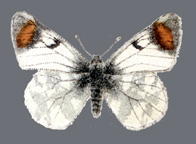
Zegris butterfly: any member of the genus Zegris Boisduval, 1837 [Pieridae, Pierinae]. The type-species, as selected by Blanchard in 1840, is Zegris eupheme Esper, 1805.
The name Zegris was coined by Rambur but first published by Boisduval in 1837 (Roret's Suite à Buffon). The reference is to a Moorish clan in fifteenth century Granada, the Zegríes, whose feud with the Abencerrajes hastened the downfall of Granada. Probably the French entomologists who named two butterflies after these clans knew of them mainly through Chateaubriand's romantic novella Les Aventures du dernier Abencerage (1826).
Seitz had only three species in the genus Zegris, two in the Old World and one in N America. The N American has been scrapped. Today there are more, all in N Africa, S Europe and into Asia. The small E European species were split off in the genus Microzegris Alphéraky, 1913. The species Nabokov undoubtedly had in mind in Ada was Zegris eupheme, a whitish pierid with a wingspan of about 45 mm. It has orange spots on the tips of its forewings with a broad dark gray margin. They make the butterfly unmistakable. It flies very rapidly, is difficult to catch and frequents agricultural lands in Morocco, E and S Spain, Turkey, Asia Minor, S Russia (where the holotype came from), Iran, up to 2,000 m.
As a movie actress, Ada took on the stage name of Theresa Zegris (p. 492), and in a letter Van called her "My Zegris butterfly" (p. 500) and "Spanish orange-tip" (p. 500–1). She is said to have "Moorish lips" (p. 402), and according to Van, "impersonates (very beautifully) a Spanish girl" (p. 498) in the movie Don Juan's Last Fling. It should also be remembered that long before an imaginary new Orange-tip had been given her name, »Antocharis ada Krolik, later changed to »Antocharis prittwitzi Stümper.
Van's short and youthful "philosophical novel" Letters from Terra was published "under the imprint of two bogus houses, 'Abencerage' in Manhattan and 'Zegris' in London" (p. 342).
In "Darkbloom's" (= Nabokov's) notes to Ada, there is this note (p. 601): "Abencerage, Zegris: Families of Granada Moors (their feud inspired Chateaubriand)." (The note is somewhat misleading as Chateaubriand's novella is not at all about the feud between the Zegris and the Abencerages but about the love of the "last Abencerage" for a Christian Spanish girl.) There is a butterfly species that carries the name of the Abencerages, Pseudophilotes abencerragus Pierret, 1837 [Lycaenidae]. It is totally unrelated to the pierid genus Zegris, being a very small blue with a wingspan of only about 22 mm, very similar to the Baton Blue (»Pseudophilotes baton). The males are dark blue with black borders, the females are dark brown. It is found in isolated colonies in Spain, Portugal and N Africa on dry land up to 2,000 m. In Spain, baton is called 'falso abencerraje'; in England, abencerragus is the 'False Baton.'
The scientific names were chosen aptly. According to Chateaubriand, the Zegris, after their expulsion from Granada, settled in the region of Fez in Morocco while the Abencerages went to Tunis. Similarly, Zegris eupheme occurs in Spain and Morocco, while the range of Pseudophilotes abencerragus is farther east, in Spain, Portugal, Algeria, Tunisia, Egypt, Near East and W Arabia.
When Nabokov towards the end of his life was dreaming about hunting whites in the Atlas mountains (Int16), he will have had Zegris eupheme on his mind.
*Ada 342, 500
& Ac: Zégris euphéme • En: Sooty Orange-tip • Fr: l'aurore d'Esper, (Ada) le papillon Zegris • Ge: *Zegris-Falter/Zegris-Weißling • Ru: белянка Эвфем • Sp: zegri
& Ac: Pseudophilótes báton • En: Baton Blue • Fr: l'azuré du thym • Ge: Graublauer Bläuling • Sp: falso abencerraje
& Ac: Pseudophilótes abencerrágus • En: False Baton Blue • Fr: l'azuré de Pierret • Sp: abencerraje
Zegris pyrothoe: »Microzegris pyrothoe
Zerynthia Ochsenheimer, 1816: a genus of »Papilionidae related to the swallowtails, but without tails. Their common name is Festoon. The black, deeply scalloped lines running along the borders of their wings give them the appearance of being notched. The range is the Mediterranean, especially the countries of the E Mediterranean. The type-species is Zerynthia polyxena DENIS & SCHIFFERMÜLLER, 1775 (ex hypsipyle Fabricius, 1777).
*StrOps 329; NabBut 583 (BE)
Zerynthia polyxena (Lampert 1907)
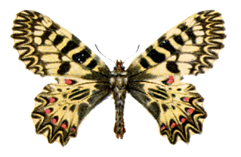
Zerynthia (ex Thais) polyxena (ex hypsipyle) Denis & Schiffermüller, 1775 [Papilionidae]: the Southern Festoon, in SE France, Ticino, Italy, SE Austria, SE Poland, Balkans, European Turkey, S Urals, NW Kazakhstan. The wingspan is 50 to 56 mm. The
& Ac: Zerýnthia polýxena • En: Southern Festoon • Ge: Osterluzeifalter • Fr: la Diane • Sp: mariposa de las aristoloquias
*Lep1 30
Zerynthia polyxena cassandra (http://e.maxicours.com)
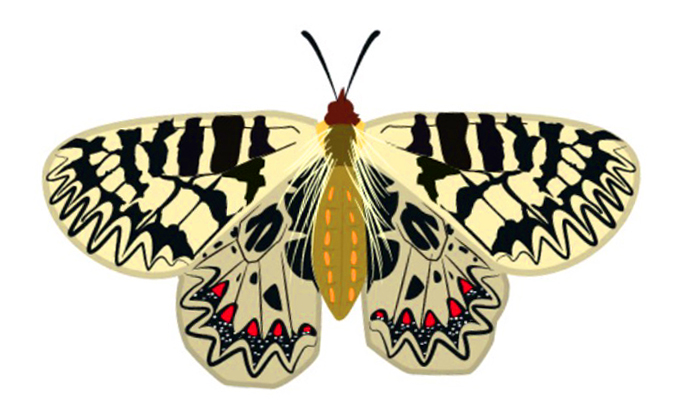
Zerynthia polyxena cassandra GEYER, 1828 [Papilionidae]: a butterfly similar to the Southern Festoon, in S France and Italy. The black markings and the red spot on the underside are larger than in Zerynthia polyxena. The wingspan is the same, 50 to 56 mm.
This is the "most delectable local enchantress" Nabokov caught in Taormina on June 8, 1970. He identifies it as "the Thais Zerynthia hypsipyle cassandra." This however is not its name but a list of some of the names that have been associated with this butterfly over time, leaving out the most important specific one, polyxena, of which cassandra is a subspecies. In detail: the generic name Thais FABRICIUS, 1807 was replaced by the senior name Zerynthia OCHSENHEIMER, 1806; hypsipyle SCHULZE, 1776 turned out to be the same as polyxena Denis & Schiffermüller, 1775 and for this reason was discarded as an invalid synonym. The subspecies cassandra GEYER always retained the name under which it was first described in 1828, Zerynthia polyxena cassandra.
& Ac: Zerýnthia polýxena cassándra • Fr: Diane cassandra • It: Polissena cassandra
* LtVé 510
Zerynthia (ex Thais) rumina Linnaeus, 1758 [Papilionidae]: the Spanish Festoon, in NW Africa, Iberian Peninsula and S France. The subspecies Zerynthia rumina africana Stichel, 1907, syn medesicaste Hoffmannsegg, 1803 was reported from N Africa.
*Lep2 268; LtVé 249
Zizula gaika: »Zizula hylax
Zizula cyna W.H. Edwards, 1881, syn tulliola Godman & Salvin, 1887 [Lycaenidae, Polyommatinae, Polyommatini, Zizula Section]: the Cyna Blue, from S Texas to Colombia, related to the African »Zizula hylax.
*NabBut 383 (L)
Zizula hylax Fabricius, 1775, syn gaika Trimen, 1862 [Lycaenidae, Polyommatinae, Polyommatini, Zizula Section]: the Tiny Grass Blue, in Africa, Arabia, Natal, Australia. It is related to the Neotropical »Zizula cyna.
*Lep9 33, 44
Zygaena carniolica (Lampert 1907)
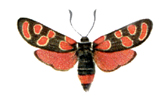
*Zygaena carniolica Scopoli, 1763 [Zygaenidae, Zygaeninae]: In Nabokov's long poem "Krym," written in 1921 in Cambridge and published in Zhar-ptitsa and later in Gorniy put', there are these lines:
I watched in wonder the day-flying moths
of the steppe ‒ with red eye-like spots
on their dark wings ... [while]
from shade to golden shade flowed
like undulating music
the ineffable Yayla!
(The Yayla are the grassy mountain tops in the south of the Crimea, altitude 1,000–1,500 m.) Ukrainian lepidopterist Professor Konstantin A. Efetov, Simferopol, a specialist on the family Zygaenidae, has very elegantly identified the moths of this poem (personal communication): "These moths are specimens of the genus Zygaena which are day-flying and most of which have red spots on the dark forewings. There are fourteen species of the genus Zygaena in the Crimea. Only eight of them can be found on Yayla. Only six among these eight have round spots ['glazki']. In five of them, these spots are red (the sixth species has yellow spots). These five species are: Zygaena carniolica (Scopoli, 1763), Zygaena loti ([Denis & Schiffermüller], 1775), Zygaena viciae ([Denis & Schiffermüller], 1775), Zygaena filipendulae (Linnaeus, 1758) and Zygaena lonicerae (Scheven, 1777). Of these five species, only one has red spots ringed by white or yellow (that is, eye-like spots): Zygaena carniolica. The vernacular Russian name of this species is 'Pyestryanka glazchataya' (compare with 's... glazkami' in Nabokov's poem). The characteristic feature of this species is that it aggregates on flowers – it is possible to see more than ten specimens on one flower! It is very common on Yayla and Nabokov cannot have failed to see specimens of it during his excursions. I conclude that the moths in Nabokov's poem are those five Zygaena species, and of course Zygaena carniolica among them."
*Gorniy put' #7
& Ac: Zygáena carniólica • Fr: la zygène de carniole, la zygène de l'esparcette • Ge: Esparsettenwidderchen, Esparsettenzygäne • Ru: пестрянка глазчатая
Zygaena filipendulae (Lampert 1907)
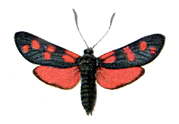
Zygaenidae Latreille, 1809: a cosmopolitan family of day-flying moths of small to medium size consisting of about 1,000 species, most of them in the Old World and in tropical Asia. Their bodies are relatively short and stout and their wings longish, with wingspans mostly in the range of 25–35 mm. Often they are saliently colored. The striking colors serve to alert predators in time, for they are poisonous. The red spots on the wings of a number of species earned them the German sobriquet 'Blutströpfchen,' droplets of blood, and these are said to have frightened peasants in the middle ages who thought it had been raining blood. Most European species are in the large genus Zygaena Fabricius, 1775. Thde type-species is Zygaena filipendulae LINNAEUS, 1758.
In The Gift, there is a "blue-and-red Burnet moth [in Russian: 'tsyganka'] with blue antennae, resembling a beetle in fancy dress, … settled on a scabiosa in company with a midge". It would be tempting to interpret the explicit mention of scabiosa as a hint to the name of the species Nabokov had in mind (Zygaena scabiosae Scheven, 1777, a junior synonym of Zygaena purpuralis Brünnich, 1763). However, according to specialist Professor Konstantin A. Efetov (personal communication), the inference would be unwarranted for several reasons. Firstly, Zygaena purpuralis does not occur in the vicinity of St. Petersburg. Secondly, there is no scabiosa proper in that part of Russia. What Nabokov termed 'Skabioza' actually is Knautia arvensis or Succisa pratensis, the only two plants of the family to which scabiosa belongs (Dipsacaceae) that grow in the region of St. Petersburg, with blue, blue-violet or white flowers. Thirdly, just about any burnet moth might settle on a herb of this family. Professor Efetov concludes (personal communication): "The 'tsyganka' Nabokov mentioned in The Gift must be one of the four Zygaena species inhabiting the region of St. Petersburg: Zygaena osterodensis (Reiss, 1921) – which was misidentified by many authors as Zygaena scabiosae, – Zygaena viciae (Denis & Schiffermüller, 1775), Zygaena filipendulae (Linnaeus, 1758) and Zygaena lonicerae (Scheven, 1777)."
*Gorniy put' #73; Gift 133
& Ac: Zygáenidae • En: burnet moths and forester moths • Fr: zygénidés (zygènes, etc.) • Ge: Zygaeniden, Widderchen, Blutströpfchen • zigenidi • Ru: пестрянки, (Dar) цыганка • Sp: zigénidos
& Ac: Zygáena filipéndulae • En: Six-spot Burnet • Fr: la zygène de la filipendule, la zygène de la spirée • Ge: Sechsfleckwidderchen, Gemeines Blutströpfchen • Ru: пестрянка лабазниковая • Sp: zigena común, zigena de seis manchas
